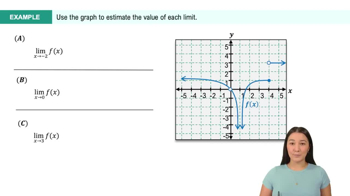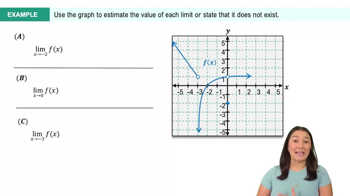Table of contents
- 0. Functions7h 52m
- Introduction to Functions16m
- Piecewise Functions10m
- Properties of Functions9m
- Common Functions1h 8m
- Transformations5m
- Combining Functions27m
- Exponent rules32m
- Exponential Functions28m
- Logarithmic Functions24m
- Properties of Logarithms34m
- Exponential & Logarithmic Equations35m
- Introduction to Trigonometric Functions38m
- Graphs of Trigonometric Functions44m
- Trigonometric Identities47m
- Inverse Trigonometric Functions48m
- 1. Limits and Continuity2h 2m
- 2. Intro to Derivatives1h 33m
- 3. Techniques of Differentiation3h 18m
- 4. Applications of Derivatives2h 38m
- 5. Graphical Applications of Derivatives6h 2m
- 6. Derivatives of Inverse, Exponential, & Logarithmic Functions2h 37m
- 7. Antiderivatives & Indefinite Integrals1h 26m
1. Limits and Continuity
Introduction to Limits
Problem 3a
Textbook Question
Use the graph of h in the figure to find the following values or state that they do not exist. <IMAGE>
h(2)
 Verified step by step guidance
Verified step by step guidance1
Identify the point on the graph where the input value is 2. This means you need to locate the x-coordinate of 2 on the x-axis.
Once you have located x = 2 on the graph, observe the corresponding y-coordinate of the point on the graph. This y-coordinate is the value of h(2).
Check if the graph has a defined point at x = 2. If there is a point, note its y-coordinate. If there is a hole or the graph is not defined at x = 2, then h(2) does not exist.
If the graph is continuous and there is a point at x = 2, then the y-coordinate of this point is the value of h(2).
Conclude by stating the value of h(2) if it exists, or state that it does not exist if the graph is not defined at x = 2.
Recommended similar problem, with video answer:
 Verified Solution
Verified SolutionThis video solution was recommended by our tutors as helpful for the problem above
Video duration:
1mPlay a video:
Was this helpful?

 6:47m
6:47mWatch next
Master Finding Limits Numerically and Graphically with a bite sized video explanation from Callie
Start learning





